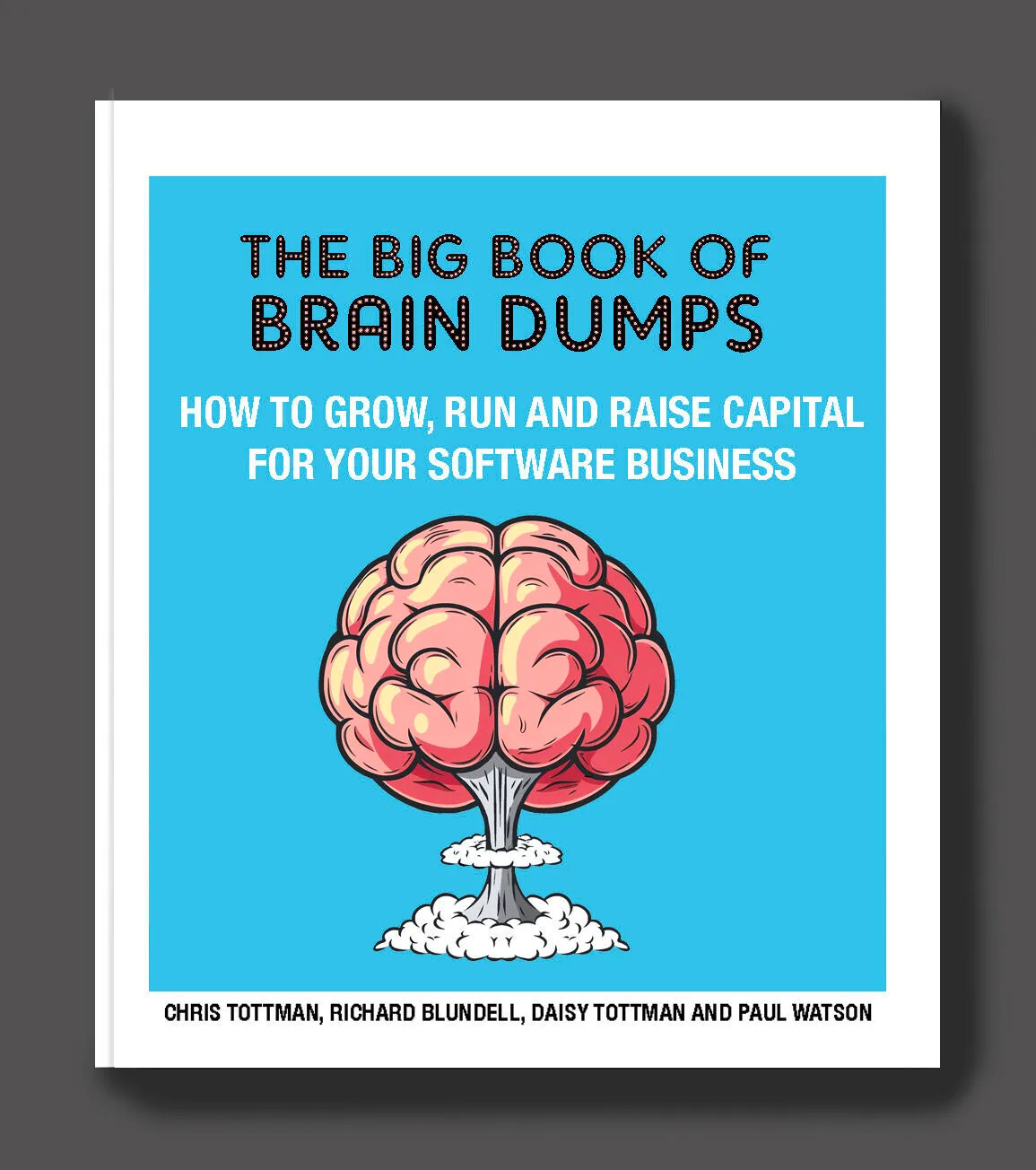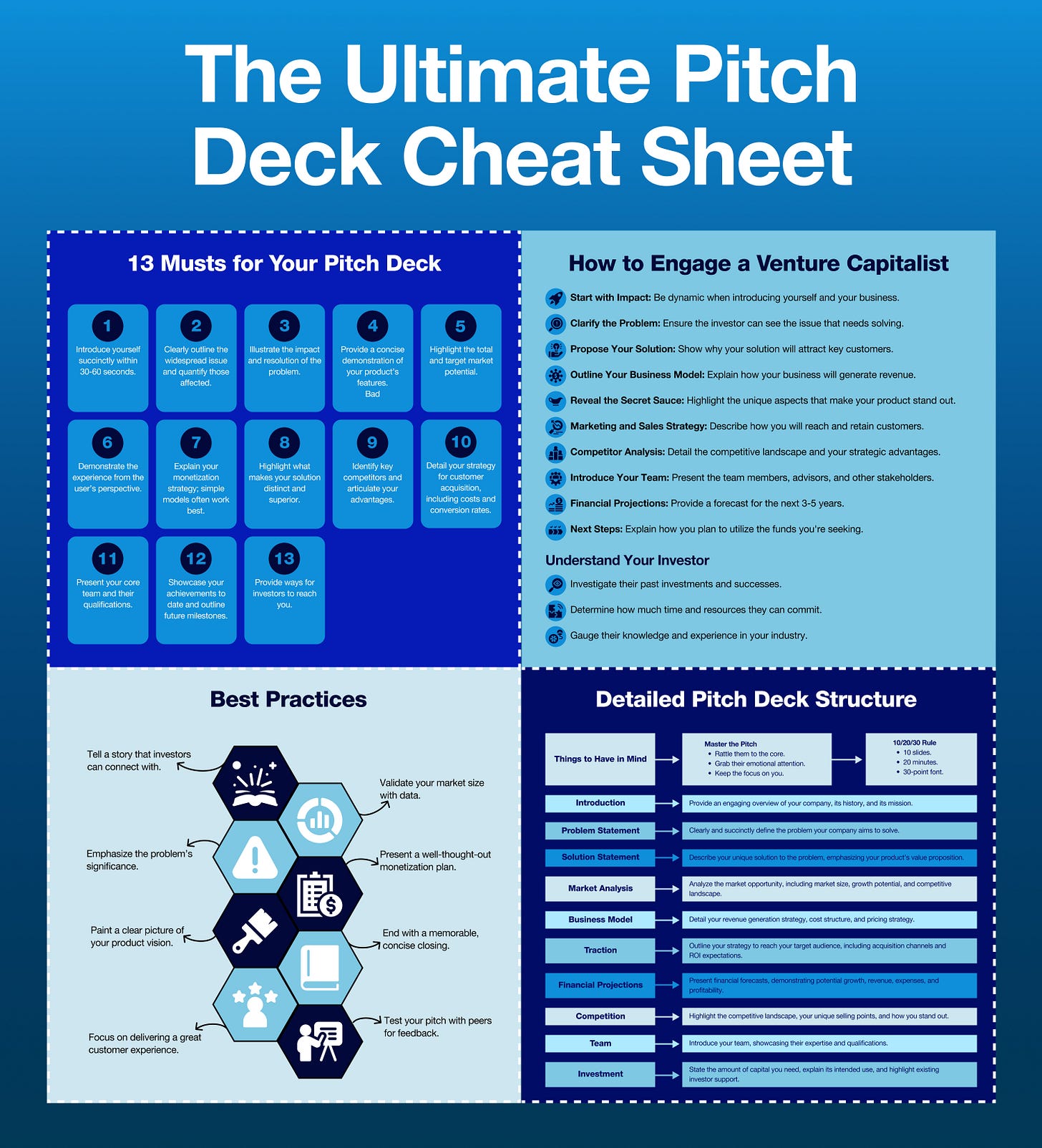🔑 Stop Losing the Room: The Pitch Deck Investors Can’t Ignore
A founder’s step-by-step guide to turning investor curiosity into conviction—slides to include, what to skip, and how to tell a story that wins meetings.
👋 Hey, Chris here! Welcome to BrainDumps—a weekly series from The Founders Corner. If you’ve been reading along, you know this series is a preview of a bigger project. Well, it’s finally here: The Big Book of BrainDumps is out now!
It isn’t a theory book—it’s the founder’s field manual. Inside, you’ll find 70 powerful frameworks distilled from 30+ years scaling software companies to hundreds of millions in ARR, 20+ years investing in 500+ B2B tech startups, and over $1B of shareholder value created. From raising capital to hiring your first VP of Sales, this book turns scars and successes into practical playbooks you’ll return to again and again. I expect most copies will become well-worn, scribbled on, and dog-eared—because it works.
📑 Table of Contents
The Purpose of a Pitch Deck (That No One Tells You)
Tell a Story That Starts with Urgency
Your Solution Slide Is Not a Feature List
Show the Market—and Why It’s Moving
Prove People Want It (With Real Evidence)
Explain How You Make Money (Clearly)
Articulate Your Moat
Know Your Competitors—Then Differentiate
Show Your GTM Plan (Not Just a Growth Chart)
Introduce the Team—But Make It Sharp
Your Roadmap Slide Is About Milestones, Not Dates
The Ask: Be Precise
Bonus: How to Engage a VC (Beyond the Deck)
Pitch Deck Best Practices (That No One Prints on a Slide)
Final Thoughts: A Great Deck Isn’t a Silver Bullet
Your pitch deck is not a product demo.
It’s not a datasheet. It’s not a wall of charts. And it’s definitely not your business plan in slide format.
Your pitch deck is a belief system.
A short, sharp, emotionally charged narrative designed to make an investor think, “If I don’t back this, someone else will—and I’ll regret it.”
And yet, I still see Founders turn up with decks that are either:
So dull they put you to sleep before Slide 4
So fluffy they belong in a creative writing class
Or so crammed with data that the actual story is lost in a forest of bar charts
So let’s fix that.
This Ultimate Pitch Deck Cheat Sheet, based on years of YC wisdom and founder battle scars, breaks down the how and why of pitch construction.
But more than that, it gives you a structure you can actually use—not just to impress investors, but to align your entire business around a sharp, compelling story.
Let’s break it down.
1. The Purpose of a Pitch Deck (That No One Tells You)
Your deck has one job:
To get you a second meeting.
That’s it.
Not to raise money on the spot.
Not to teach an investor your entire business model.
Not to list every possible use case or pricing variant.
It’s to make them want to know more.
Think of it like a movie trailer. It doesn’t tell you the whole plot—it makes you want to buy a ticket.
So every slide should answer one question:
Why is this company inevitable—and why now?
If you do that, the money conversation becomes much easier.
2. Tell a Story That Starts with Urgency
Most decks start with “Our Team” or “Our Vision.”
Wrong.
Start with the problem.
The best decks create emotional tension right away:
“This is broken.”
“People are frustrated.”
“Money is being wasted.”
“No one’s solved this yet.”
Make the problem feel painful, urgent, and massive.
If investors don’t feel it in Slide 2, they’re already checking their emails.
My Tip:
If you can’t explain the problem in 3 bullet points or a single sentence, you haven’t earned the right to talk about your solution yet.
3. Your Solution Slide is Not a Feature List
The worst pitch decks sound like product manuals.
“Our solution offers:
AI-powered integration
End-to-end automation
Scalable microservices”
Cool. But… what does it do for people?
The solution slide should visually show how your product solves the problem.
Use a diagram.
Show a workflow.
Use a before/after story.
Show a customer quote if you have one.
Make it obvious how your product creates transformation.
4. Show the Market—and Why It’s Moving
Every investor asks: Is this a big enough opportunity?
So your market slide has to nail three things:
The size of the market
The urgency of the shift
The reason you can win
Don’t just throw a TAM slide with “$87B market” on it.
Show:
Why this market is growing now
What trends are pushing adoption
What’s wrong with incumbents
Why new buyer behaviour helps you
Best decks don’t just quantify the market—they contextualise it.
5. Prove People Want It (With Real Evidence)
Investors don’t need you to be profitable at Seed.
But they do need proof that:
People use it
People love it
People will pay for it
So if you’ve got it, show:
MRR or ARR growth
Retention curves
Testimonials
Activation metrics
Waitlist numbers
Sales cycle length
Paid conversion rates
My Tip:
If you’ve only got 100 users, show how deeply they’re engaged. Usage tells a better story than vanity numbers.
6. Explain How You Make Money (Clearly)
Don’t get cute here. Don’t write:
“We’re exploring multiple monetisation strategies.”
Nope. Tell them:
Who pays you
How much they pay
How often they pay
How that scales over time
Break down pricing models:
Subscription? Freemium? Usage-based?
Tiered by user, seat, usage, or feature set?
Land-and-expand or upfront enterprise deals?
Investors want to know if your revenue model is predictable, scalable, and sensible.
7. Articulate Your Moat
A good product is not enough.
You need to show why no one else can easily do what you’re doing.
This could be:
Proprietary data
Distribution partnerships
Switching costs
Embedded use cases
Network effects
Brand trust
Patents (less important than people think)
Your unfair advantage is not what you build. It’s what makes it hard for others to catch up.
8. Know Your Competitors—Then Differentiate
Every deck needs a competitive landscape slide. And it should be realistic.
Don’t do the thing where every competitor is in the “bad” quadrant and you’re the only one in the “top-right.”
Instead:
Show you’ve studied the space
Acknowledge strengths of others
Highlight where you’re different (not just better)
My Tip:
Great founders say:
“Here’s where we overlap, and here’s where we’re betting the world’s changing.”
That’s strategy.
9. Show Your GTM Plan (Not Just a Growth Chart)
This is where most decks go vague.
“We’ll acquire customers through organic, paid, partnerships and virality.”
…Great. So will everyone else.
Break it down:
Who are your ICPs?
How will you reach them?
What channels have shown early traction?
What’s your CAC so far?
What’s your sales motion? PLG? SDR? Founder-led?
Even a basic funnel is better than hand-waving.
Investors don’t need it to be perfect—they need to see you’re thinking like a business builder.
10. Introduce the Team—But Make It Sharp
Don’t spend 4 slides here.
Just show:
Who’s building what
Why they’re credible
What experience they bring
Where the gaps are (be honest)
If you’ve got relevant domain experience, say it loud.
My Tip:
Slides with smiling team photos and job titles don’t cut it. Show why this team has an unfair edge.
11. Your Roadmap Slide Is About Milestones, Not Dates
Investors know your timeline will slip. What they want to know is:
What are the key milestones?
What does success look like in 12–18 months?
What does the next raise unlock?
This slide should connect the use of funds to the traction you plan to create.
Tie this to:
Team hiring
GTM channels
Product evolution
ARR or usage goals
Make it easy to see what progress looks like—and what you’re optimising for.
12. The Ask: Be Precise
Too many decks end with:
“We’re raising money to scale.”
That’s a non-starter.
Say:
How much you’re raising
What % of equity that represents (if priced)
How long it gives you
Where the money will go
What you expect to achieve with it
Confidence + clarity = conviction.
13. Bonus: How to Engage a VC (Beyond the Deck)
This part of the cheat sheet is pure gold, and founders often forget it.
Pitching isn’t just what you say—it’s how you engage.
Here’s what works:
🧠 Know Your Audience
Do your homework. Who have they backed? What stage do they like? What themes do they talk about? Personalise the intro.
📬 Craft a Killer Intro Email
Short. Direct. Confident. Include traction in the first 2 lines.
🗣️ Own the Narrative
Control the tempo. Lead the conversation. Don’t just walk through slides—tell a story.
📊 Answer Questions with Precision
VCs love clarity. If you don’t know the answer, say so—and tell them how you’ll find out.
🔁 Follow Up Like a Pro
Recap what you heard. Send additional info fast. Keep momentum high.
🧭 Always Have a Next Step
Don’t leave the room without knowing what’s next—call, IC meeting, partner intro.
Pitch Deck Best Practices (That No One Prints on a Slide)
📽️ Tell a Story
Make it emotional. Urgent. Visionary. The best decks are mini-films, not PDF brochures.
🧱 Build Logic Step-by-Step
Don’t jump around. Walk the investor from problem → solution → market → traction → moat → business model → team → roadmap → ask.
🎯 Stay Focused
No more than 12–15 slides. Every word earns its place. Less is more.
🎨 Use Visuals to do the Heavy Lifting
People remember images, diagrams, and charts. A clear chart beats a paragraph.
💥 End with Conviction
You want the last slide to stick. This is where you say: “This is the company you want to back.”
Final Thoughts: A Great Deck Isn’t a Silver Bullet—But a Bad One Will Kill the Conversation
You don’t need the “perfect” deck to raise money.
You need a deck that tells your story with clarity, emotion, and credibility.
One that shows:
There’s a real problem
You’ve got a better solution
The market is pulling you forward
Your team is the one to build it
You know how to get there
And you know exactly what you need to do it
And here’s the thing most founders miss:
The process of building a great deck forces you to build a better business.
The questions you answer in that pitch?
They’re the same ones you’ll face every week for the next 3 years.
So take the time. Get it right.
Your future self—and your investors—will thank you.
—Chris Tottman




Amazing resource for getting investors on our side!
I especially love the first one... it is not to get money right away, but to peak curiousity and get a second meeting.
Thanks for this!! It's really helpful :))